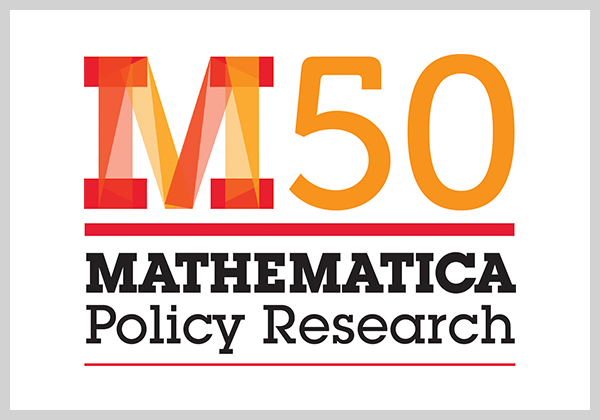
M50 Timeline: Mathematica Through the Years
As a nation, as a research community, and as a company, much has changed. But our commitment to rigorous, objective evidence that informs and elevates public policy remains as relevant today as it was in 1968. Explore just a few of the moments, milestones, and memorable projects that have shaped the Mathematica of today.

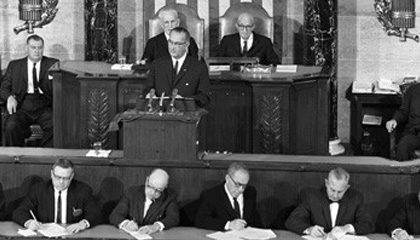
“Our task is to help replace their despair with opportunity”
On January 8, 1964, President Johnson declares “unconditional war on poverty in America” during his State of the Union address. The speech sets the stage for the package of legislation and domestic programs that would later be known as the “Great Society.”
Listen to a recording of the speech
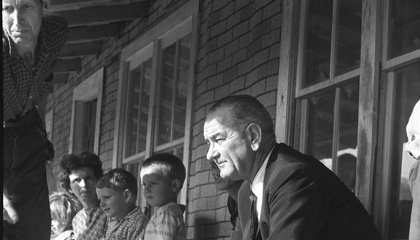
President Johnson seeks “to eliminate the paradox of poverty in the midst of plenty”
The Economic Opportunity Act of 1964, a milestone of the “War on Poverty,” was signed by President Johnson on August 20, 1964. The act created a number of new programs, including Job Corps, with the goal of opening opportunity to everyone—for education and training, for work, and for living with decency and dignity.
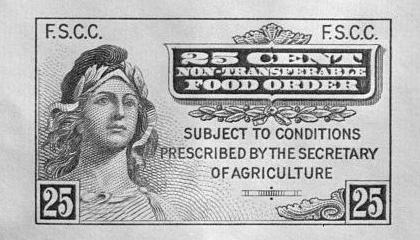
The Food Stamp Program becomes “one of our most valuable weapons for the War on Poverty”
President Johnson signed the Food Stamp Act of 1964 on August 31, 1964. The act created a permanent Food Stamp Program after a three-year pilot “raised the diets of low-income families substantially, while strengthening markets for the farmer and immeasurably improving the volume of retail food sales.”
Read President Johnson’s remarks

Head Start gets started
In its first summer, Head Start served more than 560,000 students at roughly 2,000 child development centers across the country. The program combined preschool training, medical and dental services, and counseling for parents to help disadvantaged children get a head start on their future.

Medicare and Medicaid are created
President Johnson traveled to Independence, Missouri, to sign amendments to the Social Security Act. These amendments created Medicare, a health insurance program for the elderly, and Medicaid, a similar program for the poor. The signing took place at the Truman Presidential Library, where former President Truman became the first to enroll in Medicare.
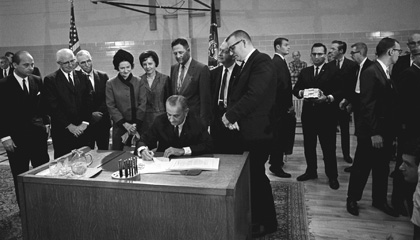
President Johnson signs the Higher Education Act of 1965
“This legislation . . . will swing open a new door for the young people of America. For them, and for this entire land of ours, it is the most important door that will ever open—the door to education. And this legislation is the key which unlocks it.”
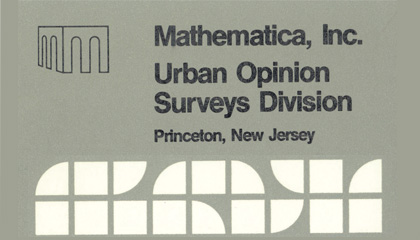
The Urban Opinion Surveys Division is launched/Mathematica Policy Research is started
Mathematica Policy Research was formed to conduct the first major social research experiment, the New Jersey Negative Income Tax Experiment.
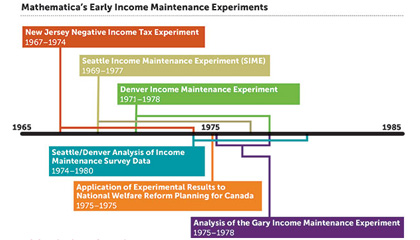
Mathematica explores whether a guaranteed income reduces labor supply
A negative income tax (NIT), which guarantees people a basic income, was widely proposed as a way to eliminate poverty. But policymakers had questions about program costs and whether workers would work less.
Four social experiments, the first of their kind, were fielded to generate evidence on this topic, starting with the New Jersey NIT Experiment in 1968. Researchers found strong evidence of major work disincentives coupled with a rise in marital dissolution, which effectively ended support for this policy approach.


Mathematica’s DC office opens

Urban Opinion Surveys is incorporated as Mathematica Policy Research
David Kershaw becomes president of the new firm.
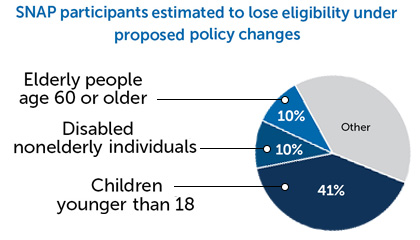
Microsimulation models of the Food Stamp Program help policymakers understand proposed changes
As the largest domestic program providing food and nutrition support, the Supplemental Nutrition Assistance Program (SNAP)—formerly the Food Stamp Program—is subject to public scrutiny and periodic reform efforts.
Since the mid-1970s, Mathematica has developed and maintained computer microsimulation models to assess proposed changes to SNAP. Mathematica also produces SNAP’s Quality Control data file for public use, which is considered the gold standard for research on the characteristics of SNAP participants.

The National Supported Work Demonstration helps open the door to welfare reform
The National Supported Work Demonstration was one of the most important and closely studied policy experiments of the 1970s. It offered employment and supports to four groups: mothers enrolled in Aid to Families with Dependent Children, ex-offenders, ex-addicts, and out-of-school youth.
Somewhat to the surprise of program designers, Mathematica found that AFDC mothers remained in the program longer and responded more positively to services than did other participants. These findings became the foundation for the extensive experimentation and ultimate redesign of our nation’s welfare system in the 1980s and 1990s.

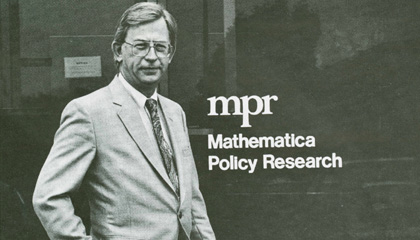
William Morrill becomes president of Mathematica
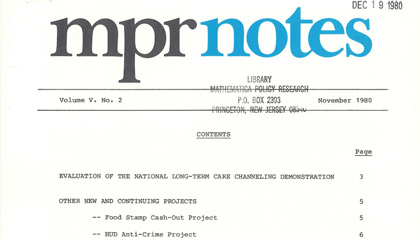
The National Long-Term Care Demonstration explores the outcomes of aging at home
Many frail elders want to keep living in their homes rather than move to a nursing home. For the National Long-Term Care Demonstration, Mathematica tested the use of case-managed community services to enable frail elders to age at home. The services improved well-being for elders and their caregivers but did not reduce nursing home admissions, which remained low. As a result, the services tended to raise total costs slightly.

The Tax Equity and Financial Responsibility Act of 1982 allows HMOs to provide Medicare coverage
Fee-for-service payments for Medicare lead to the overuse of expensive health care services—and thus higher costs. The HMO model changed health care reimbursements to a fixed per-capita payment. But this model raised concerns that beneficiaries were being underserved.
The Medicare Risk Program, authorized in 1985, allows HMOs, for the first time, to provide Medicare coverage for beneficiaries in return for a fixed, prepaid payment.
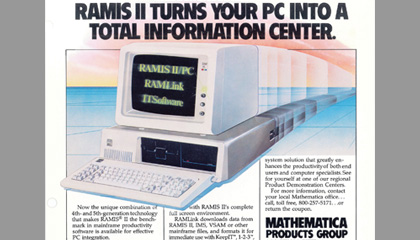
Mathematica is sold to Martin Marietta Data Systems
The systems developed by Mathematica for state lotteries were an attractive business opportunity for Martin Marietta.

Staff buy Mathematica from Martin Marietta Data Systems for $2.9 million
In a bold move, 39 employees bought 4,765 shares from Martin Marietta and recreated Mathematica as an employee-owned company.

Charles Metcalf is named president of Mathematica
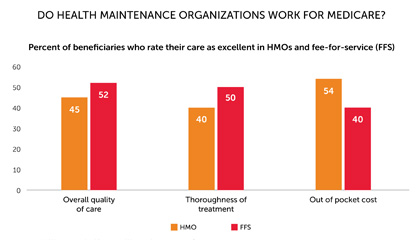
Mathematica explores whether HMOs work for Medicare
Mathematica gauged the effects of the Medicare Risk Program, which allows HMOs to provide Medicare coverage, on total expenditures and access to care. The evaluation showed that HMOs provided care of comparable quality to that delivered by fee-for-service providers. But contrary to the program’s intent, Medicare’s costs actually rose.
The findings led to an overhaul of the payment methodology to account for HMOs’ healthier-than-average enrollees. Today, nearly one-third of all Medicare beneficiaries receive coverage from an HMO.
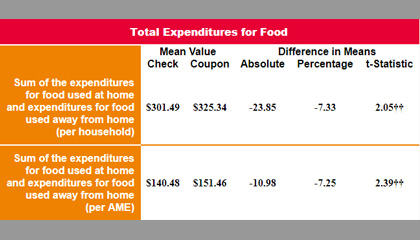
Mathematica uncovers the effects of food stamp cashout
A long-standing issue in the Food Stamp Program and in SNAP is whether the form of the benefits provided—cash, coupons, EBT cards—matters.
Based on data from four demonstrations of food stamp cashout conducted in the late 1980s, Mathematica concluded that benefit form does indeed matter. Food stamps boost spending on food more than cash benefits do. This finding played a role in the decision to leave the Food Stamp Program out of the block grant funding authorized by the Personal Responsibility and Work Opportunity Reconciliation Act of 1996 (PRWORA).

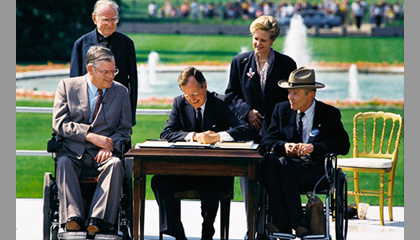
The Americans with Disabilities Act is signed
In 1990, President George H.W. Bush signed the landmark Americans with Disabilities Act into law. The law prohibits discrimination against people with disabilities in the areas of employment, access to public facilities, and access to public transportation.
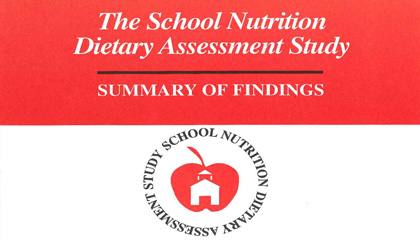
The School Nutrition Dietary Assessment Studies shed light on the quality of school meals
The U.S. Department of Agriculture administers two school meals programs—the National School Lunch Program and the School Breakfast Program. For the past 25 years, Mathematica has studied the nutritional content of meals offered to students and the diets of program participants. Our study findings, along with developments in nutritional guidance, have had a dramatic impact on the quality of school meals.
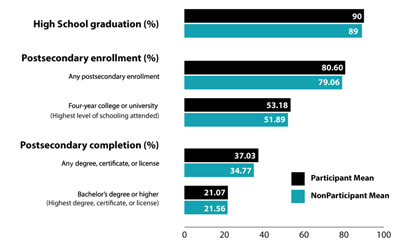
Mathematica evaluates Upward Bound, one of the largest federal education programs
Upward Bound is one of the largest and longest-running federal programs to help disadvantaged students prepare for, enter, and succeed in college. Mathematica conducted a 19-year random assignment evaluation of the program using a nationally representative sample of Upward Bound projects.
Although Upward Bound had no impact on the rate of overall postsecondary enrollment, it increased the chance of earning a postsecondary certificate from a vocational school. Furthermore, longer participation in Upward Bound was linked to higher rates of postsecondary enrollment and completion.
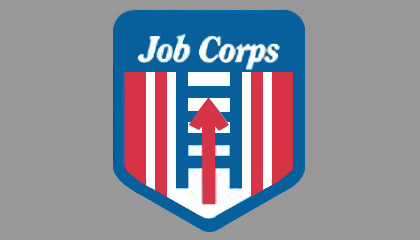
Mathematica studies whether Job Corps helps youth become more responsible, employable, and productive citizens
The National Job Corps Study was the first nationally representative experimental evaluation of a federal employment and training program for youth. Mathematica randomly assigned nearly 81,000 eligible applicants to either a program group, which was offered Job Corps services, or to a control group. We found that Job Corps increased educational attainment, curbed criminal activity, and boosted earnings for several years post-program.
We are currently conducting a 22-year followup with the study sample.
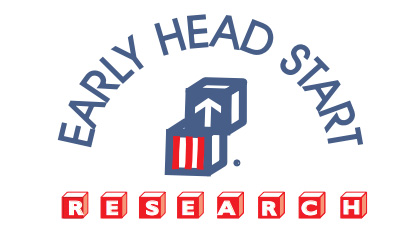
Early Head Start shows the benefits of investing early in children’s success
Early Head Start expanded the federal commitment to address the needs of low-income families with pregnant women, infants, and toddlers up to age 3.
Mathematica’s random assignment evaluation showed that participating children performed significantly better in cognitive, language, and social-emotional development than their peers. The program also had important impacts on many aspects of parenting and the home environment, and it supported parents’ progress toward economic self-sufficiency.

Mathematica’s Cambridge office opens
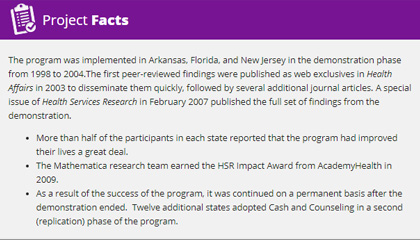
Mathematica conducts influential study on Medicaid enrollees managing their own care
Mathematica conducted a random assignment study to assess the effects of allowing Medicaid enrollees to manage their own home-based, long-term personal care by using their needs-based allowance to hire, schedule, and direct their own caregivers or to purchase assistive devices.
We found that program participants were much more satisfied with the care received—and reported far fewer unmet needs—than the control group. Family caregivers of participants also reported much less physical, emotional, and financial stress and fewer health problems than the caregivers of control group members. Moreover, the treatment group gave equal or better ratings to all measures of the quality of their home care.
Mathematica’s evaluation team received AcademyHealth’s Impact Award in 2009 for the influence the study had on policy.

The PRWORA ends “welfare as we know it”
The Personal Responsibility and Work Opportunity Reconciliation Act of 1996 (PRWORA) dramatically changed the nation’s welfare system. The PRWORA replaced a primarily cash-based system with one that requires work in exchange for time-limited cash assistance. It also promoted personal responsibility and teen pregnancy prevention.
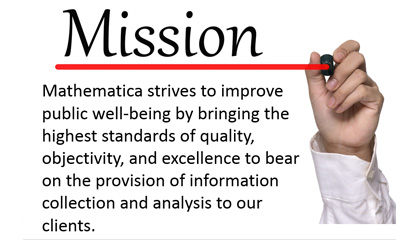
Mathematica unveils official mission statement
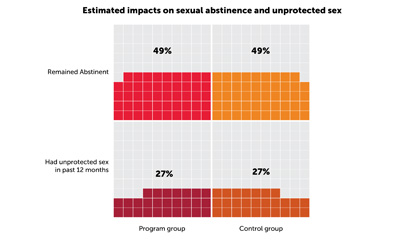
Mathematica conducts award-winning study of abstinence education
The Abstinence Education Program authorized under the PRWORA increased both the funding and prominence of abstinence-only education.
Mathematica’s national random assignment evaluation showed that youth receiving abstinence-only education were no more likely than control group youth to abstain from sex. But contrary to concerns raised by critics of abstinence education, youth receiving abstinence-only education were no more likely to have had unprotected sex than youth in the control group.
We received the American Evaluation Association’s Evaluation of the Year Award for this work.

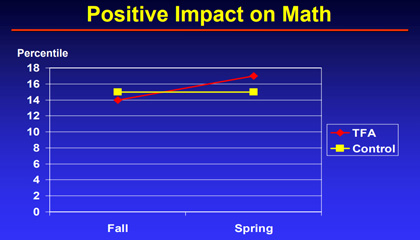
Teach for America studies show the value of alternative routes to teacher certification
Alternative routes to teacher certification are a popular but controversial means to address teacher shortages. Critics contend that teachers prepared through alternative routes are less prepared to teach and less effective than teachers from traditional certification programs.
Mathematica conducted two rigorous evaluations of Teach for America (TFA), a highly selective alternative route. Both studies showed that TFA teachers improved students’ math achievement by an amount roughly equal to one additional month of math instruction for elementary math teachers and over two additional months of instruction for secondary math teachers.

No Child Left Behind becomes law
Passed with overwhelming bipartisan support in summer 2001, No Child Left Behind was signed by President George W. Bush to improve students’ education outcomes. The law required all public schools receiving federal funding to administer a statewide standardized test to all students each year. It also required schools to rely on “research that involves the application of rigorous, systematic, and objective procedures to obtain reliable and valid knowledge relevant to education activities and programs.”
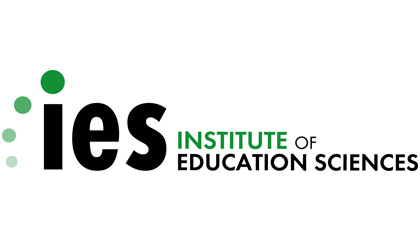
The Institute of Education Sciences is created
The Education Sciences Reform Act of 2002, signed by President Bush on November 5, 2002, authorized the creation of the Institute of Education Sciences. The institute houses the National Center for Education Research, National Center for Education Statistics, and National Center for Education Evaluation and Regional Assistance.

The What Works Clearinghouse launches
The U.S. Department of Education created the What Works Clearinghouse to serve as a “central and trusted source of scientific evidence of what works in education.”
Mathematica began operating the clearinghouse in 2007, helping to make it a model for other federal clearinghouses and the gold standard for using research to improve educational practice. Our diverse set of resources across a growing array of topics continues to help educators, researchers, and policymakers identify quality research and discern what works and what doesn’t.

Mathematica conducts its largest project to date: Building Strong Families
Three of the PRWORA’s four policy goals involve family formation. In response, Mathematica helped create Building Strong Families, a “relationship education” program for low-income, unmarried couples with children. We then conducted an 11-year, multisite evaluation of the program’s impact on couples’ relationship quality and marital status.
Overall, this first generation of relationship education programs for low-income couples had no impact on relationship quality, except for Building Strong Families in Oklahoma City, which improved relationship quality, romantic involvement, co-parenting, and father involvement.
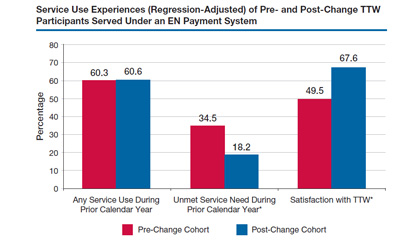
Mathematica’s 10-year evaluation of Ticket to Work begins
Few Social Security disability beneficiaries leave the rolls as a result of finding work. The Ticket to Work and Work Incentives Improvement Act of 1999 was an attempt to help more beneficiaries do so by (1) paying service providers to help beneficiaries find and keep jobs and (2) providing other work supports, such as access to health insurance and benefits counseling.
In a 10-year evaluation, Mathematica assessed program implementation and helped the Social Security Administration refine the program and increase participation levels.
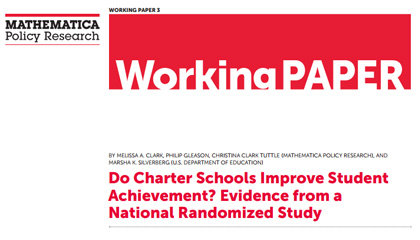
Mathematica examines whether charter schools boost student achievement
Designed to free educators from bureaucratic rules to and encourage innovation, charter schools are public schools that have more autonomy over how they are run. They operate under a charter with their state that specifies the standards they must meet.
Mathematica conducted an experimental evaluation of the impact of attending a charter school on student achievement and parental satisfaction. The impacts varied considerably across schools and students, with positive impacts for more disadvantaged students and schools and negative impacts for more advantaged students and schools. The impacts on student and parent satisfaction were positive and statistically significant.
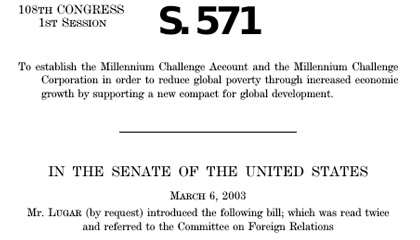
The Millennium Challenge Corporation is created
Created by Congress with strong bipartisan support, the Millennium Challenge Corporation seeks to reduce poverty, stimulate economic growth, and strengthen institutions around the world. It provides U.S. foreign assistance that focuses on good policies, country ownership, and proven results.

Mathematica creates an employee stock ownership plan
As a benefit to all employees, Mathematica launched an employee stock ownership plan to provide staff with shares of stock and an ownership interest in the company.
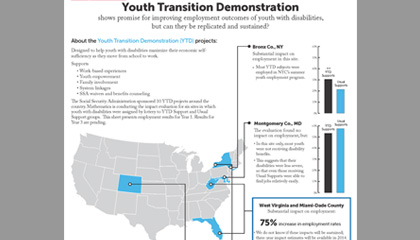
The Youth Transition Demonstration shows promise for helping youth with disabilities become successful adults
The transition to adulthood for youth with disabilities can be especially difficult. To explore this issue, Mathematica conducted a random assignment evaluation of an initiative by the Social Security Administration to provide job services and enhanced work incentives to young people with severe disabilities. Three of the six study sites significantly increased paid employment among these youth.

Mathematica examines Burkina Faso’s efforts to help girls succeed
In 132 villages, the Burkina Faso government built new schools offering “girl-friendly” features, such as housing for female teachers, separate latrines and take-home rations for girls, new classrooms, free textbooks, school supplies, and mentoring for young girls.
Mathematica’s 10-year study showed that enrollment and test scores rose for both girls and boys, with larger impacts on girls. The changes also boosted primary school completion and enrollment in school—while decreasing employment and marriage—among girls and young women.

Paul Decker becomes Mathematica’s president and CEO
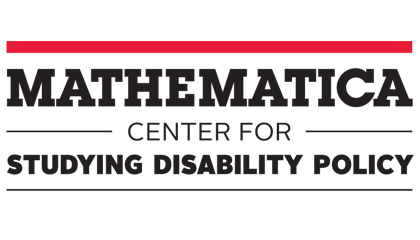
The Center for Studying Disability Policy is created
Mathematica’s Center for Studying Disability Policy provides policymakers and program administrators with the evidence they need to make informed decisions that support effective disability policies and programs. The researchers analyze and evaluate interventions designed to empower people with disabilities, improve outcomes, and promote efficient use of limited resources.
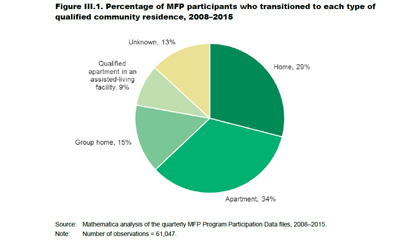
Money Follows the Person shifts the balance of Medicaid spending from institutions to the community
The Centers for Medicare & Medicaid Services launched Money Follows the Person (MFP) to help states move people with chronic conditions and disabilities from institutions back into the community. The program is the largest demonstration of its kind in the history of Medicaid.
Mathematica conducted a comprehensive 10-year evaluation of MFP, finding that participants reported major improvements in quality of life. The program also generated significant savings in health care costs.
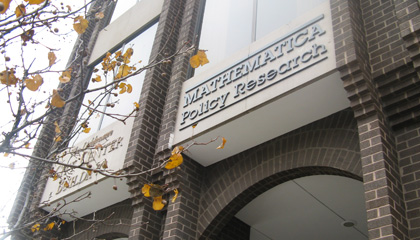
Mathematica’s Ann Arbor office opens
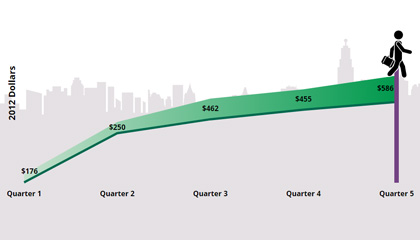
Mathematica studies the Adult and Dislocated Worker programs, which focus on the growing need for a more skilled workforce
Mathematica conducted a nationally representative experimental evaluation of the staff assistance and training services offered by these programs.
Created under the Workforce Investment Act of 1998, the Adult and Dislocated Worker programs are two of the nation’s largest employment programs, serving about 8 million people annually.
Mathematica conducted a nationally representative experimental evaluation of the staff assistance and training services offered by these programs.
Fifteen months after study enrollment, participants offered staff assistance were more likely to have jobs and earned more than people who were not offered this assistance. We are still assessing the impacts of training based on the 15-month follow-up data.
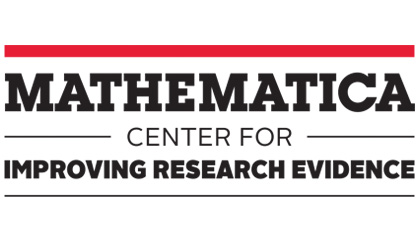
The Center for Improving Research Evidence is created
Mathematica’s Center for Improving Research Evidence is driven by a mission to build capacity to understand and use evidence, plan rigorous and relevant evaluations, and strengthen research methods and standards.

Mathematica’s Oakland office opens

Mathematica’s Chicago office opens

As the workforce changes, registered apprenticeships rise to the policy forefront
Apprenticeship programs have long been recognized as a means of moving low-skilled workers into careers that pay middle-class wages. Mathematica conducted a quasiexperimental impact and cost-benefit analysis of a career-training program that offers on-the-job training combined with technical instruction tailored to industry needs.
We found that employment rates among participants were 8.6 percentage points higher—and annual earnings were almost $6,500 greater—than those of similar nonparticipants. The benefits to society greatly outweighed the costs of the program over the medium and long term.

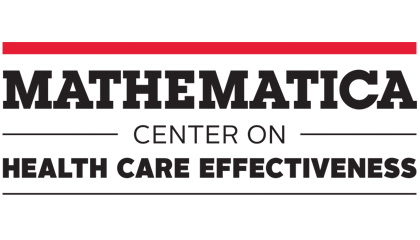
The Center on Health Care Effectiveness is created
Mathematica’s Center on Health Care Effectiveness conducts and disseminates research and policy analysis that support better decisions at the point of care. Its focus is on the delivery system and policy environment that help clinicians and patients make informed decisions using information on outcomes and effectiveness.
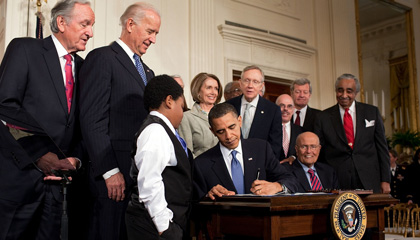
The Patient Protection and Affordable Care Act becomes law
Enacted in March 2010, the Affordable Care Act seeks to make high quality, affordable health care available for all Americans. The law provides consumers with subsidies, expands Medicaid, establishes health insurance exchanges, prohibits insurers from denying coverage because of pre-existing conditions, and supports innovative health care programs and policies to lower the costs of care.
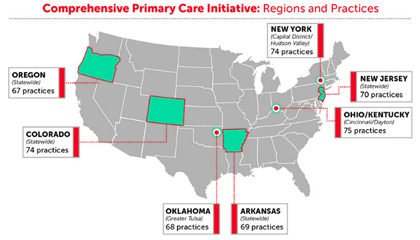
The Comprehensive Primary Care Initiative seeks to improve quality and reduce costs
In this four-year, multipayer initiative, Mathematica tested whether Medicare could improve care and lower overall costs by providing (1) advanced primary care practices and additional financial resources to Medicare beneficiaries, (2) feedback on their performance, and (3) technical assistance from regional learning networks.
Mathematica found that practices made major changes in how they delivered care, but the program reduced traditional Medicare costs by only 1 percent. On the other hand, major improvements in care delivery were linked to fewer hospitalizations among practices in the Comprehensive Primary Care Initiative, providing guidance for future efforts to transform practices.
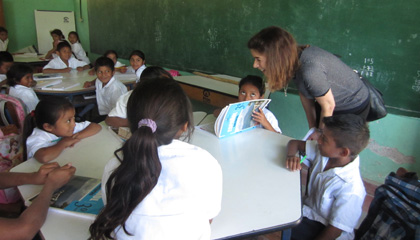
The Latin America and the Caribbean Reads evaluation offers insight into promising education programs
As part of an eight-year effort, Mathematica is rigorously evaluating the impact and cost-effectiveness of a number of USAID’s investments in early literacy and access to education in conflict areas in Peru, Guatemala, Honduras, El Salvador, and Nicaragua.
One of the programs, Amazonía Lee, trained teachers and provided in-class coaching and materials. By the end of the second program year, the model had improved students’ simple word reading, decoding, reading fluency, and reading comprehension in the district where control schools did not have access to a comparable educational program.
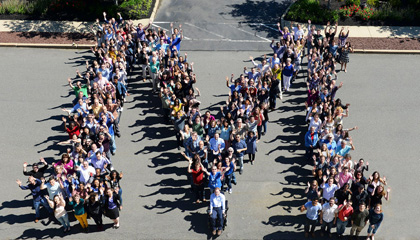
Mathematica reaches 1,000 employees
Mathematica grew from just 81 regular, full-time staff at the time of the company’s buyout in 1986 to 1,000 employees in 2013.
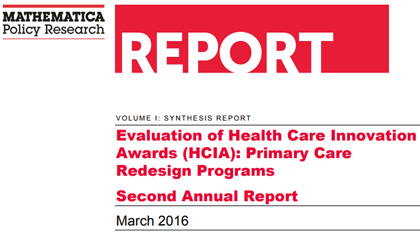
Mathematica weighs the impacts of the Health Care Innovation Awards on costs and quality of care
The Centers for Medicare & Medicaid Services has funded 146 unique programs to test creative ways to deliver and pay for health care under Medicare and Medicaid. Using a variety of rigorous study designs, Mathematica is evaluating whether these new programs improve quality and lower costs.
So far, 14 programs focused on transforming primary care, 4 improved the quality of care processes, and 3 others reduced hospitalizations or emergency room admissions. Of the 10 programs designed to improve care for behavioral health and substance abuse disorders, 3 were found to reduce Medicare or Medicaid expenditures.
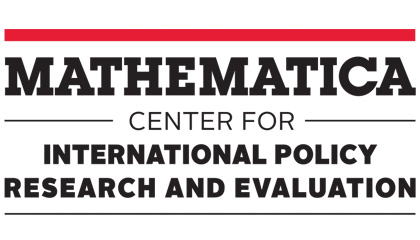
The Center for International Policy Research and Evaluation is created
Mathematica’s Center for International Policy Research and Evaluation provides high quality and objective research-based information to funders and policymakers tackling major problems around the globe.

Mathematica’s Tucson office opens
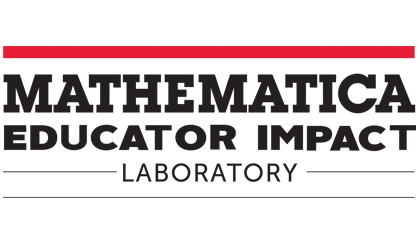
The Educator Impact Lab is launched
Mathematica’s Educator Impact Laboratory helps state and local education leaders develop and apply the latest tools and methods to measure educators’ impact on their students, put these findings into context, and use them to improve education.
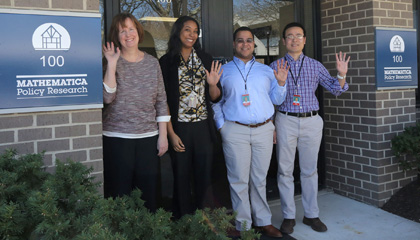
Mathematica’s Woodlawn office opens

